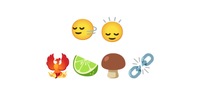
News + Trends
Head shake, mushroom and broken chains: This is the emoji vintage 2023
by Jan Johannsen

Smileys help many people to interpret messages correctly. But not everyone uses them, which can lead to misunderstandings.
Few things can throw me into deeper confusion than a message without a smiley. Is the person who replied to me angry? Annoyed? Did they misinterpret my question? Or simply doesn't have the time? I ask myself tons of questions and curse these totally emotionless letters that give me no social nuance.
Yes, I'm exaggerating a bit, but indeed, I find it harder to assess my interlocutor or interlocutor in a chat if he or she doesn't help me with emojis. To me, some messages seem less friendly and more dry when they're devoid of emoji. Most of the time, a simple smiley face is enough to reassure me that all is well.
Like me, most people who use emojis in their online communication are in the same situation. Several studies, such as "Future of Creativity" from 2022 and "Ein Bild sagt mehr als tausend Worte" from 2018 by Cologne's Fresenius University, have already noted this.
The triumphant march of smileys began in the early years of the Internet, and it is now impossible to imagine online communication without them. There are now more than 3,600 emojis, many of them variations on skin colour. They are used to replace gestures, tone and body language in personal conversations, which are lacking in the written domain. 70% of participants in a long-term study by the Fraunhofer Institute believe that emojis can help avoid misunderstandings in written language.
Written communication is indeed a science in itself: people write quite differently with friends and family than they do with colleagues, acquaintances or complete strangers. There are fewer emojis in e-mails than in chats. Women use emojis more often than men, young people more often than older people, and those who don't use emojis may look unfriendly, but according to the Fresenius study, they are also more self-confident: people who reject emojis appear to want to keep their moods to themselves and don't care what anyone thinks of them.
Yes, written language is complex: some people interpret a lot of things where others see no hidden meaning. Even a point that concludes a chat message has a passive-aggressive effect on many people, as it can be interpreted as "unwanted discussion".
Do you use emojis yourself?
The competition has ended.
There are two visions: people who use emojis as tools in their text message to serve as an additional communication channel. And people who only have the exchange of information in mind and don't much appreciate coloured images in text. And both have their raison d'être.
It is precisely in the commercial sphere, for example in emails between customers and service providers, that the pure transmission of information comes to the fore. That's where the facts count, especially in tense areas such as price negotiations, reminders or complaints. Even I wouldn't have the idea of using smileys in this context.
But apart from that, I don't think there's anything against communicating with a slightly lighter tone and a discreet little 🙂 after the "Thank you for your reply". I want to make it clear that it's not just empty words, but that it really made my day. Nevertheless, in emails, I don't expect my interlocutor to use smileys. However, when he or she does, I'm all the happier.
At the latest since the teleworking trend, many companies are relying on chat tools for internal communication. Colleagues exchange ideas and consult each other. This is generally quicker than by e-mail or telephone. And here too, emojis are increasingly common.
Here are a few products for anyone who can't get enough of emojis: [[product:37709000,22619451,22548830]]
This is compounded by the fact that programs such as Outlook, Teams and Google Docs support emoji feedback. This support is sometimes only a year old. A heart in reaction to a chat message or e-mail expresses in the blink of an eye a "thank you", a thumbs-up, a "that's all right". However, it's more about saving time here.
Wherever they are, emojis are for me a sign of openness to discussion. A smile can be followed by a joke and a conversation can be born from a joke. Without emojis, I find it difficult. And even if it were, with strangers it's hard to tell the difference between jokes and seriousness without help in chat. The scope for misunderstanding is too great.
What do you think of emojis? When do you use them, and when don't you? Do they help you as much as they do me?
Headline photo: Rawpixel.com/Shutterstock
Feels just as comfortable in front of a gaming PC as she does in a hammock in the garden. Likes the Roman Empire, container ships and science fiction books. Focuses mostly on unearthing news stories about IT and smart products.
Interesting facts about products, behind-the-scenes looks at manufacturers and deep-dives on interesting people.
Show all